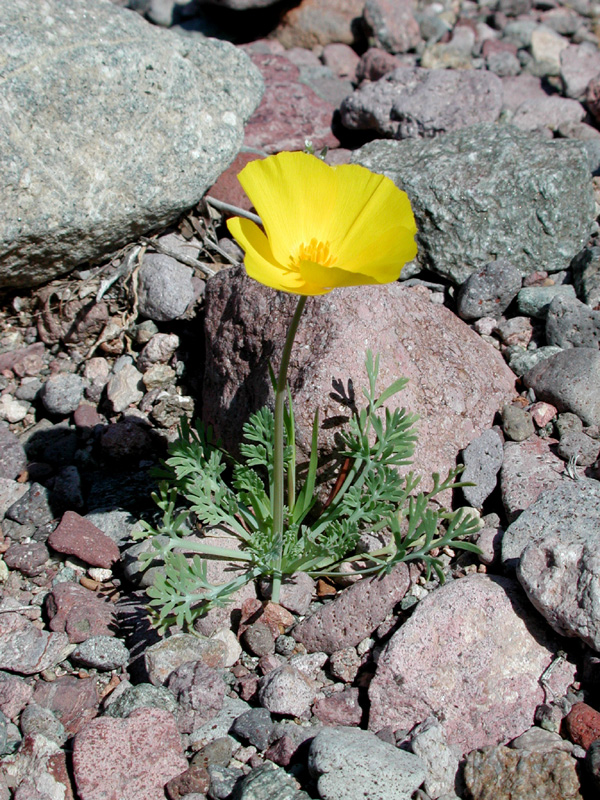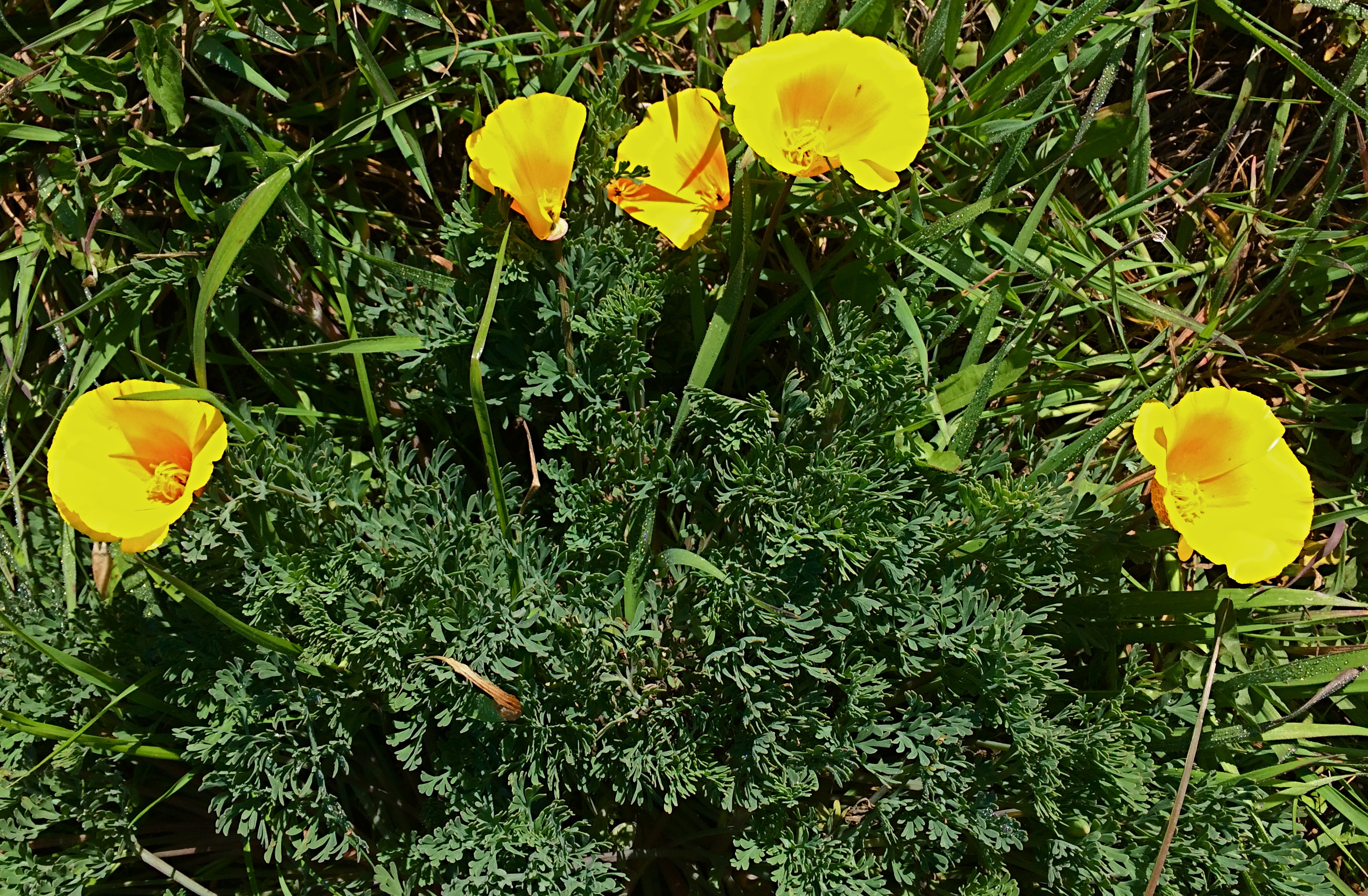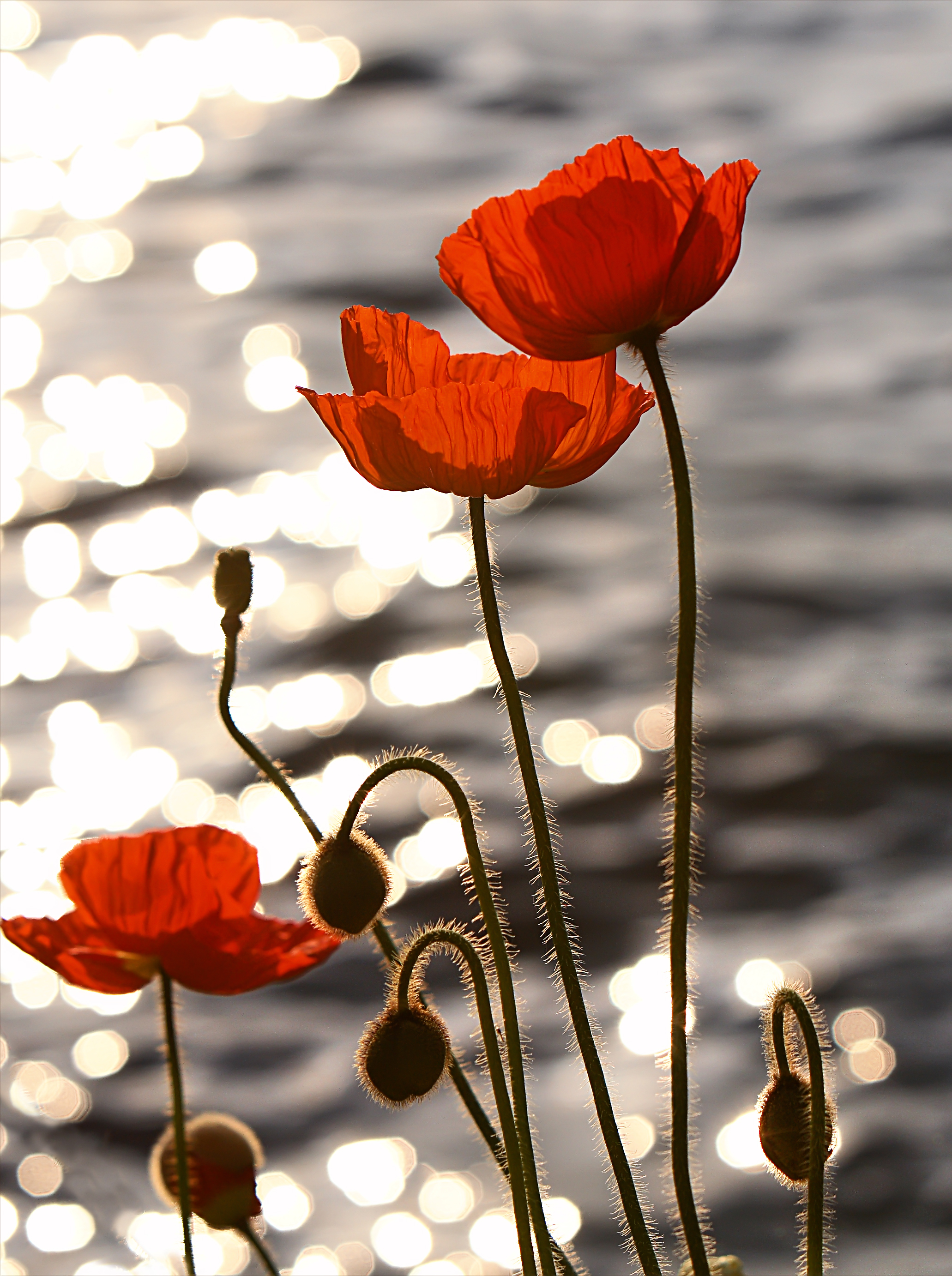|
Eschscholzia
''Eschscholzia'' is a genus of 12 annual or perennial plants in the Papaveraceae (poppy) family. The genus was named after the Baltic German/Imperial Russian botanist Johann Friedrich von Eschscholtz (1793–1831). All species are native to Mexico or the southern United States. Description Leaves are deeply cut, glabrous and glaucous, mostly basal, though a few grow on the stem. Flowers have four yellow or orange petals, and grow at the end of the stem, either alone or in many-flowered cymes. The petals are wedge-shaped, forming a funnel. The two fused sepals fall off as the flower bud opens. There are 12 to numerous stamens. The flowers close in cloudy weather. Seeds are tiny and black, held in long pointed pods that split open when ripe often with enough force to fling the seeds some distance with an audible snap. The taproot gives off a colorless or orange clear juice, which is mildly toxic. Cultivation The best-known species is the California poppy (''Eschscholzia calif ... [...More Info...] [...Related Items...] OR: [Wikipedia] [Google] [Baidu] |
Eschscholzia Androuxii
''Eschscholzia'' is a genus of 12 annual or perennial plants in the Papaveraceae (poppy) family. The genus was named after the Baltic German/Imperial Russian botanist Johann Friedrich von Eschscholtz (1793–1831). All species are native to Mexico or the southern United States. Description Leaves are deeply cut, glabrous and glaucous, mostly basal, though a few grow on the stem. Flowers have four yellow or orange petals, and grow at the end of the stem, either alone or in many-flowered cymes. The petals are wedge-shaped, forming a funnel. The two fused sepals fall off as the flower bud opens. There are 12 to numerous stamens. The flowers close in cloudy weather. Seeds are tiny and black, held in long pointed pods that split open when ripe often with enough force to fling the seeds some distance with an audible snap. The taproot gives off a colorless or orange clear juice, which is mildly toxic. Cultivation The best-known species is the California poppy (''Eschscholzia calif ... [...More Info...] [...Related Items...] OR: [Wikipedia] [Google] [Baidu] |
California Poppy
''Eschscholzia californica'', the California poppy, golden poppy, California sunlight or cup of gold, is a species of flowering plant in the family Papaveraceae, native to the United States and Mexico. It is cultivated as an ornamental plant flowering in summer (spring in southern Australia), with showy cup-shaped flowers in brilliant shades of red, orange and yellow (occasionally pink and white). It is also used as food or a garnish. It became the official state flower of California in 1903. Description California Poppy is a perennial or annual plant growing to tall with alternately branching glaucous blue-green foliage. The leaves are alternately divided into round, lobed segments. The flowers are solitary on long stems, silky-textured, with four petals, each petal long and broad; flower color ranges through yellow, orange and red (with some pinks). Flowering occurs from February to September in the northern hemisphere (spring, summer, fall). The petals close at nigh ... [...More Info...] [...Related Items...] OR: [Wikipedia] [Google] [Baidu] |
Eschscholzia Californica
''Eschscholzia californica'', the California poppy, golden poppy, California sunlight or cup of gold, is a species of flowering plant in the family Papaveraceae, native to the United States and Mexico. It is cultivated as an ornamental plant flowering in summer (spring in southern Australia), with showy cup-shaped flowers in brilliant shades of red, orange and yellow (occasionally pink and white). It is also used as food or a garnish. It became the official state flower of California in 1903. Description California Poppy is a perennial or annual plant growing to tall with alternately branching glaucous blue-green foliage. The leaves are alternately divided into round, lobed segments. The flowers are solitary on long stems, silky-textured, with four petals, each petal long and broad; flower color ranges through yellow, orange and red (with some pinks). Flowering occurs from February to September in the northern hemisphere (spring, summer, fall). The petals close at night ... [...More Info...] [...Related Items...] OR: [Wikipedia] [Google] [Baidu] |
Eschscholzia Caespitosa (2561051742)
''Eschscholzia caespitosa'' is a species of poppy known by the common names foothill poppy, tufted poppy and collarless California poppy. It is native to western North America from Oregon, across California, to Baja California where it is a member of the chaparral plant community. Description ''Eschscholzia caespitosa'' is an annual herb which is quite similar in appearance to its relative, the California poppy ''Eschscholzia californica'', the California poppy, golden poppy, California sunlight or cup of gold, is a species of flowering plant in the family Papaveraceae, native to the United States and Mexico. It is cultivated as an ornamental plant f .... It produces patches of foliage made up of several leaflets per leaf and thin, erect stems up to in height. The poppy flower has orange to yellow petals each long. The fruit is a cylindrical capsule long containing tiny dark netted seeds. External linksCalFlora Database: ''Eschscholzia caespitosa'' (Foothill poppy, Tu ... [...More Info...] [...Related Items...] OR: [Wikipedia] [Google] [Baidu] |
Poppy
A poppy is a flowering plant in the subfamily Papaveroideae of the family Papaveraceae. Poppies are herbaceous plants, often grown for their colourful flowers. One species of poppy, ''Papaver somniferum'', is the source of the narcotic drug opium which contains powerful medicinal alkaloids such as morphine and has been used since ancient times as an analgesic and narcotic medicine, medicinal and recreational drug. It also produces Poppy seed, edible seeds. Following the trench warfare in the poppy fields of Flanders, Belgium during World War I, poppies have become a symbol of Remembrance Day, remembrance of soldiers who have died during wartime, especially in the UK, Canada, Australia, New Zealand and other Commonwealth realms. Description Poppies are herbaceous plant, herbaceous Annual plant, annual, Biennial plant, biennial or short-lived Perennial plant, perennial plants. Some species are monocarpic, dying after flowering. Poppies can be over a metre tall with flowers up to 1 ... [...More Info...] [...Related Items...] OR: [Wikipedia] [Google] [Baidu] |
Johann Friedrich Von Eschscholtz
Johann Friedrich Gustav von Eschscholtz (1 November 1793 – 7 May 1831)Sterling (1997) was a Baltic German physician, naturalist, and entomologist. He was one of the earliest scientific explorers of the Pacific region, making significant collections of flora and fauna in Alaska, California, and Hawaii. Biography Eschscholtz was born in the Livonian city of Dorpat, then part of the Russian Empire. His parents, Johann Gottfried and Katherine Hedwig Ziegler Eschscholtz were ethnic Baltic Germans. He studied medicine and zoology at the University of Dorpat and served as an assistant to Carl Friedrich von Ledebour, a professor of botany.McKelvey Eschscholtz received a medical degree in 1815. First voyage On the recommendation of Ledebour, Eschscholtz served as surgeon and naturalist on the Russian expeditionary ship ''Rurik'' under the command of Otto von Kotzebue.Daum (2019) From 1815 to 1818 the expedition circumnavigated the globe for the purposes of seeking a Northwest Passage ... [...More Info...] [...Related Items...] OR: [Wikipedia] [Google] [Baidu] |
Papaveraceae
The Papaveraceae are an economically important family of about 42 genera and approximately 775 known species of flowering plants in the order Ranunculales, informally known as the poppy family. The family is cosmopolitan, occurring in temperate and subtropical climates (mostly in the northern hemisphere), but almost unknown in the tropics. Most are herbaceous plants, but a few are shrubs and small trees. The family currently includes two groups that have been considered to be separate families: Fumariaceae and Pteridophyllaceae. Description The plants may be annual, biennial, or perennial. Usually herbaceous, a few species form shrubs or evergreen trees. They are lactiferous, producing latex, which may be milky or watery, coloured or plain. All parts contain a well-developed duct system (these ducts are called "laticifers"), producing a milky latex, a watery white, yellow or red juice. The simple leaves are alternate or sometimes whorled. They have petioles and are not enc ... [...More Info...] [...Related Items...] OR: [Wikipedia] [Google] [Baidu] |
Chamisso
Adelbert von Chamisso (; 30 January 178121 August 1838) was a German poet and botanist, author of ''Peter Schlemihl'', a famous story about a man who sold his shadow. He was commonly known in French as Adelbert de Chamisso (or Chamissot) de Boncourt, a name referring to the family estate at Boncourt. Life The son of Louis Marie, Count of Chamisso, by his marriage to Anne Marie Gargam, Chamisso began life as Louis Charles Adélaïde de Chamissot at the ''château'' of Boncourt at Ante, in Champagne, France, the ancestral seat of his family. His name appears in several forms, one of the most common being ''Ludolf Karl Adelbert von Chamisso.''Rodolfo E.G. Pichi Sermolli. 1996. ''Authors of Scientific Names in Pteridophyta''. Royal Botanic Gardens, Kew. In 1790, the French Revolution drove his parents out of France with their seven children, and they went successively to Liège, the Hague, Würzburg, and Bayreuth, and possibly Hamburg, before settling in Berlin. There, in 179 ... [...More Info...] [...Related Items...] OR: [Wikipedia] [Google] [Baidu] |
Imperial Russia
The Russian Empire was an empire and the final period of the List of Russian monarchs, Russian monarchy from 1721 to 1917, ruling across large parts of Eurasia. It succeeded the Tsardom of Russia following the Treaty of Nystad, which ended the Great Northern War. The rise of the Russian Empire coincided with the decline of neighbouring rival powers: the Swedish Empire, the Polish–Lithuanian Commonwealth, Qajar Iran, the Ottoman Empire, and Qing dynasty, Qing China. It also held colonies in North America between 1799 and 1867. Covering an area of approximately , it remains the list of largest empires, third-largest empire in history, surpassed only by the British Empire and the Mongol Empire; it ruled over a population of 125.6 million people per the Russian Empire Census, 1897 Russian census, which was the only census carried out during the entire imperial period. Owing to its geographic extent across three continents at its peak, it featured great ethnic, linguistic, re ... [...More Info...] [...Related Items...] OR: [Wikipedia] [Google] [Baidu] |
Latex
Latex is an emulsion (stable dispersion) of polymer microparticles in water. Latexes are found in nature, but synthetic latexes are common as well. In nature, latex is found as a milky fluid found in 10% of all flowering plants (angiosperms). It is a complex emulsion that coagulates on exposure to air, consisting of proteins, alkaloids, starches, sugars, oils, tannins, resins, and gums. It is usually exuded after tissue injury. In most plants, latex is white, but some have yellow, orange, or scarlet latex. Since the 17th century, latex has been used as a term for the fluid substance in plants, deriving from the Latin word for "liquid". It serves mainly as defense against herbivorous insects. Latex is not to be confused with plant sap; it is a distinct substance, separately produced, and with different functions. The word latex is also used to refer to natural latex rubber, particularly non-vulcanized rubber. Such is the case in products like latex gloves, latex condoms ... [...More Info...] [...Related Items...] OR: [Wikipedia] [Google] [Baidu] |
Genus
Genus ( plural genera ) is a taxonomic rank used in the biological classification of extant taxon, living and fossil organisms as well as Virus classification#ICTV classification, viruses. In the hierarchy of biological classification, genus comes above species and below family (taxonomy), family. In binomial nomenclature, the genus name forms the first part of the binomial species name for each species within the genus. :E.g. ''Panthera leo'' (lion) and ''Panthera onca'' (jaguar) are two species within the genus ''Panthera''. ''Panthera'' is a genus within the family Felidae. The composition of a genus is determined by taxonomy (biology), taxonomists. The standards for genus classification are not strictly codified, so different authorities often produce different classifications for genera. There are some general practices used, however, including the idea that a newly defined genus should fulfill these three criteria to be descriptively useful: # monophyly – all descendants ... [...More Info...] [...Related Items...] OR: [Wikipedia] [Google] [Baidu] |
Joshua Tree Poppy (Eschscholzia Androuxii) (16750830288)
Joshua () or Yehoshua ( ''Yəhōšuaʿ'', Tiberian: ''Yŏhōšuaʿ,'' lit. 'Yahweh is salvation') ''Yēšūaʿ''; syr, ܝܫܘܥ ܒܪ ܢܘܢ ''Yəšūʿ bar Nōn''; el, Ἰησοῦς, ar , يُوشَعُ ٱبْنُ نُونٍ '' Yūšaʿ ibn Nūn''; la, Iosue functioned as Moses' assistant in the books of Exodus and Numbers, and later succeeded Moses as leader of the Israelite tribes in the Hebrew Bible's Book of Joshua. His name was Hoshea ( ''Hōšēaʿ'', lit. 'Save') the son of Nun, of the tribe of Ephraim, but Moses called him "Yehoshua" (translated as "Joshua" in English),''Bible'' the name by which he is commonly known in English. According to the Bible, he was born in Egypt prior to the Exodus. The Hebrew Bible identifies Joshua as one of the twelve spies of Israel sent by Moses to explore the land of Canaan. In Numbers 13:1, and after the death of Moses, he led the Israelite tribes in the conquest of Canaan, and allocated lands to the tribes. According to bibl ... [...More Info...] [...Related Items...] OR: [Wikipedia] [Google] [Baidu] |
_(16750830288).jpg)







